Goldfish are one of the most common, friendly fish you can have in your aquarium. However, they are prone to conditions like red spots.
If you are wondering why there are red spots on goldfish and how to cure it, you’ve come to the right place. In this guide, we will discuss all about red spots, why it occurs, medication, and how to treat it.
So without delaying any further, let’s dive right in!
Why Does My Goldfish Have Red Spots?
Three main factors can contribute to your goldfish developing red spots: red pest disease (hemorrhagic septicemia), enteric redmouth (ERM) disease, and ammonia poisoning. We will discuss all of these in detail below.
#1 Reason: Goldfish Red Pest Disease
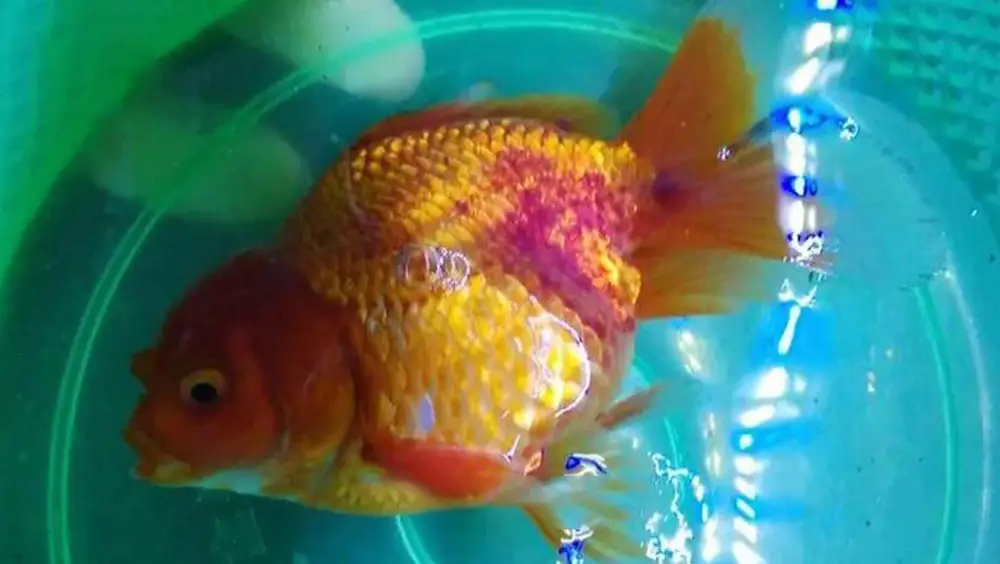
Red Pest, or hemorrhagic septicemia, is an acute, highly fatal [1] internal bacterial disease that affects goldfish and other freshwater fish, causing them to develop red, bloody streaks on their gills, eyes, bodies, and the base of the fins.
Most bacteria that cause infections in fresh and marine fish fall into one of two groups: gram-positive or gram-negative [2], named for how they respond to gram staining.[3] Due to their different type of outer structures (cell walls), gram-positive bacteria appear purple to blue, and gram-negative bacteria stain pink to red.
The difference between these two types of bacteria is important when trying to determine which antibiotics to use, as some only treat gram-positive bacteria while others are effective against gram-negative bacteria. Gram-negative bacteria tend to be more resistant to antibiotics.[4]
Gram-negative bacteria (GNB) are among the most significant pathogens of fish, including genera: Pseudomonas, Aeromonas, Flavobacterium, Vibrio, and Yersinia. Aeromonas species are often associated with hemorrhagic septicemia (Red Pest), and Flavobacterium columnare is the biggest culprit of columnaris disease in aquarium fish.
Hemorrhagic septicemia (red pest) is also highly contagious [5], making it difficult to treat and often leading to mass die-offs in aquariums and ponds. However, this bacterial disease has not been reported to infect humans, so there is no need to worry about handling your fish.
Signs of Red Pest Disease in Goldfish
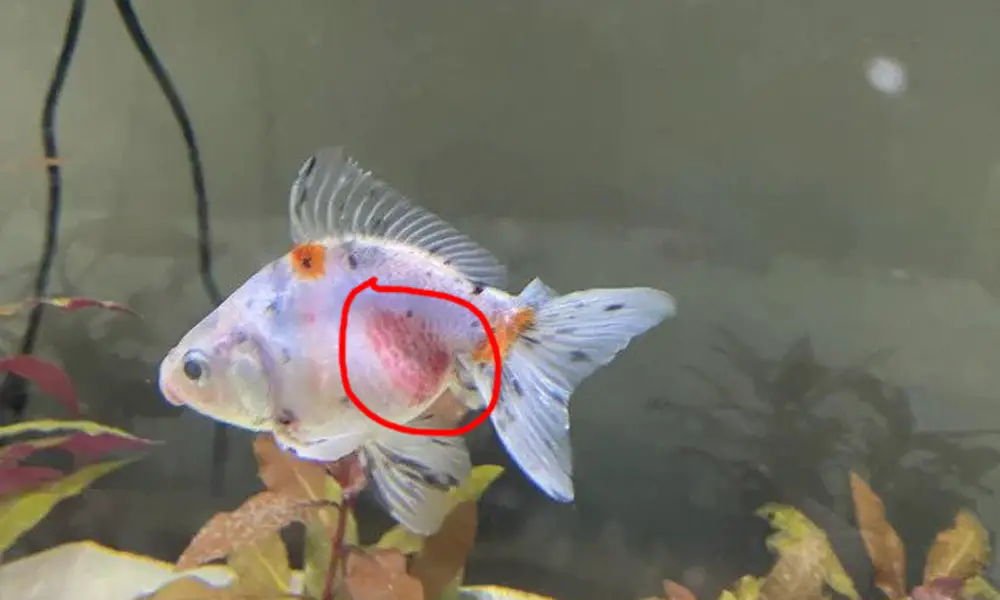
As the name suggests, the most common symptom of red pest disease in goldfish is red spots or streaks (hemorrhages) on the body, gills, and fins. In addition, fish may also display:
- Pop eyes,
- Bloated (fluid-filled) belly
- Loss of coloration
- Abnormal swimming behavior
From my first-hand experience, it can be difficult to diagnose an internal bacterial infection in goldfish. In most cases, goldfish infected with Hemorrhagic septicemia may show no signs of illness in its early stages, but the disease can still spread, leading to contagion. During the middle stage, you may notice scattered white spots or dots on the fish’s body and fins. However, if the disease is at a more advanced stage, your goldfish will develop more and more red streaks or spots on their bodies and fins.
In some severe cases, the entire fish body may become covered in red sores and ulcers. Red pest is often fatal; even with treatment, the mortality rate can be as high as 80-100%.
Goldfish Red Pest Disease Causes
Interestingly, most bacteria that cause red pests or other diseases in fish, whether they belong to gram-positive or gram-negative, are actually normal inhabitants in the fish tank or pond and don’t usually cause problems in healthy fish.
These opportunistic pathogens take advantage and cause disease only when the fish’s immune system is not functioning properly. So, red pest disease is often seen as a secondary infection, following another underlying condition that has weakened the fish’s immune system.
Virtually all fish diseases can be traced to some form of stress factor, which weakens their immune system. The most common stressors that can lead to the fish disease include:
- Poor water quality
- Incorrect water chemistry
- Inadequate filtration
- Overcrowding
- Poor diet
- Injuries
- Transportation stress
- Leaving your aquarium lights on 24/7
- Aggression from other tank mates
In addition, a goldfish with a weak immune system may be more prone to bacterial growth, further exacerbating the problem.
How Do You Treat Red Pest in Goldfish?
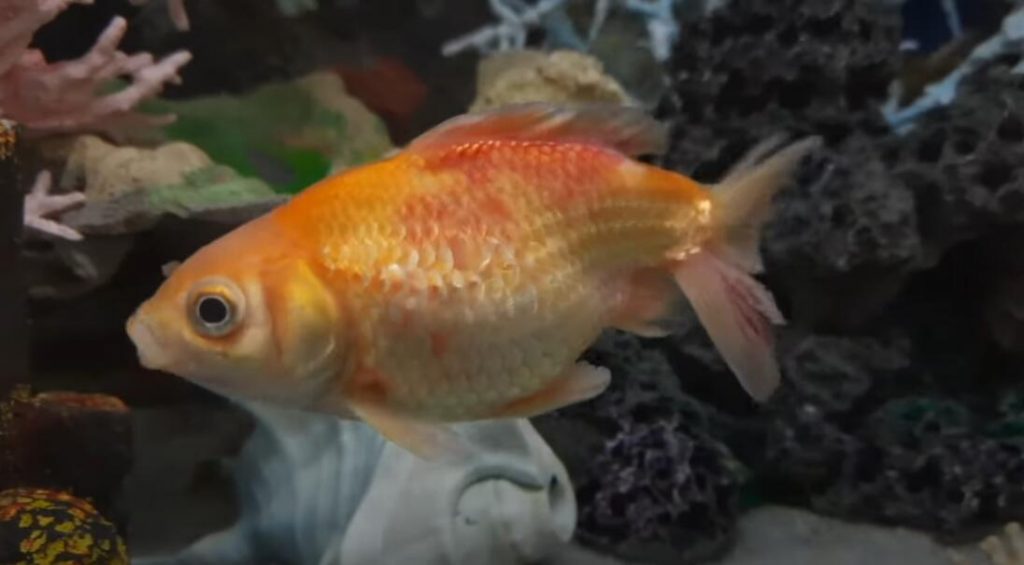
Since Hemorrhagic septicemia (red pest) is a very serious internal fish disease, external medications are not going to work, the only way to save your fish is through antibiotic treatment.
Author note: External remedies may help if the disease is in its early stages, but I’d recommend still using a broad-spectrum antibiotic instead.
It’s important to realize that antibiotics do not cure a fish. Instead, they merely suppress the growth of bacteria populations in your goldfish long enough for the fish’s immune system to recover and naturally eliminate bacteria.
Making and Feeding Medicated Feed
The most effective way to treat red pest disease or other bacterial infections is to add antibiotics to the fish’s food. Generally, you can make your own medicated feeds by adding antibiotics to dry flake or making gelatin-based food. I highly favor the latter simply because it sinks rapidly.
- Prepare 3 ounces (85 g) unflavored dry gelatin (like Knox gelatin)
- Grind 1 ounce (28 g) of dry commercial fish food (pellets or flake) to a powder (similar size of the dry gelatin)
- Mix the fish food and the gelatin powder together in a bowl
- Add 1/2 ounce (1 tablespoon) of the antibiotic powder to the mixture. Avoid using stronger doses if the case isn’t severe, as their side effects can still cause harm. Stir well to ensure that the antibiotic powder is evenly distributed in the mixture.
- Heat 2 cups of water to near boiling, then pour over 2 to 3 ounces of the mixture above while stirring constantly. The gelatin will dissolve, and the mixture will form a gel. You may add more hot water if the mixture appears too dry, while if it appears too wet, just add a small amount of dry mixture (typically not necessary).
- Spread the gelled mixture onto a silicone baking sheet or wax paper with even thickness. Allow the gel to cool and solidify in a refrigerator.
- Once it’s cooled, you can cut the gel into small squares, put them into a plastic bag, and store them in the freezer until you’re ready to use them.
No products found.
Feed at least twice daily for at least ten days, offering the amount all your fish will completely consume in less than 3-5 minutes.
I would also recommend starving your fish a little before feeding them, and this will help encourage them to eat the medicated food.
Be aware that you should never use homemade medicated fish food more than ten days old. Freshness is key to success.
External Bath Treatment
An antibiotic feeding treatment can be accompanied by external bath and dip treatments using sulfa or nitrofurans drugs.
Nitrofurans are commonly used to treat ornamental fish, including nitrofurantoin, nitrofurazone, furanace, and furazolidone. The well-known drugs in this class are Seachem Focus and Hikari BiFuran
Three things to remember when using these drugs include:
- They are most effective against superficial bacterial skin infections because they do not penetrate the skin well.[6] Remove the fish from the bath immediately if you see any redness.
- Nitrofurans can be degraded by light, so the fish tank should be covered during the treatment.
- Nitrofurans are more toxic to fish than sulfa drugs.
Sulfonamides, or “sulfa drugs,” are the other broad-spectrum antibiotics used to treat bacterial infections. The better-known drugs with this ingredient include SeaChem SulfaPlex (69%), API Triple Sulfa, and Mardel Maracyn Plus. However, they are not as effective as they once were due to antibiotic abuse.
To treat a goldfish with sulfa or nitrofurans drugs bath, consider using five times the recommended dosage of the nitrofurans or ten times the recommended dosage of the sulfa drugs for only one hour every day.
Continue bathing for at least three days after the symptoms have disappeared to ensure the infection does not recur.
If you have any questions, please consult a qualified aquarium veterinarian. As with any medication, use it as directed. Do not over-medicate, which can lead to health problems for your fish.
#2 Reason: Enteric Redmouth (ERM) Disease in Goldfish
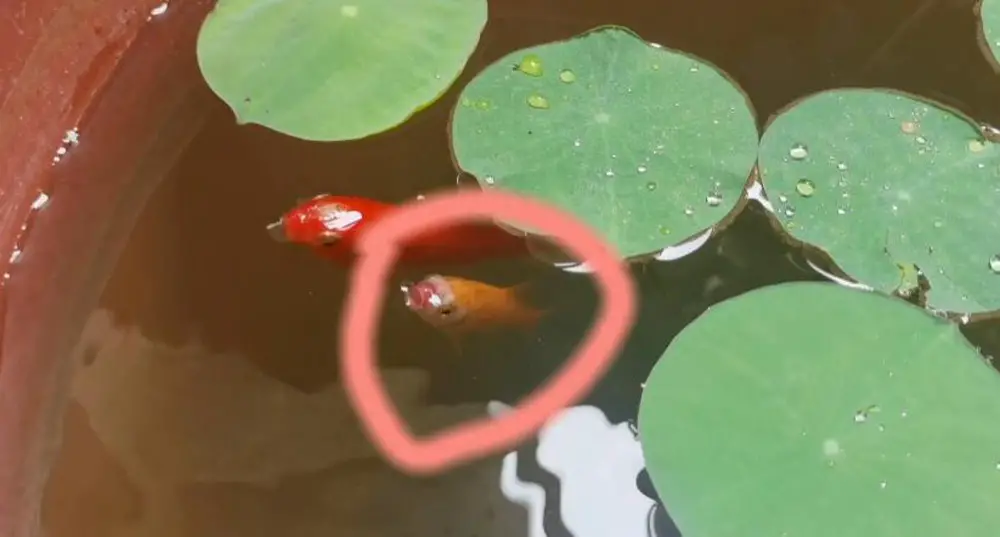
Quite often, you’ll see red spots just on the goldfish’s mouth. This enteric redmouth disease is one of the particular viral hemorrhagic septicemia (VHS) caused by the bacterium Yersinia ruckeri.[7]
As we’ve already mentioned in an earlier section, Yersinia ruckeri is a gram-negative bacteria. The bacterium enters the fish through the secondary gill lamellae, where it multiplies and quickly invades the fish’s blood and internal organs. Of course, it’s a serious infectious disease that will kill the goldfish if it’s not treated in time.
Signs of Redmouth Disease In Goldfish

As its name suggests, this enteric redmouth disease can cause subcutaneous hemorrhages in the mouth, including gums, throat, and gums. The major clinic signs included:
- Reddening of the mouth, opercula
- Popeye (exophthalmia)
- Discoloration
- Inflammation of the jaws and palate
- Blood red blotches at the base of fins
- Thick yellow fluid in the intestine
Redmouth Disease Treatment
Treatment of redmouth disease is no different than treating any other bacterial infection in goldfish. You can use the same treatment for the red pest disease we’ve already mentioned.
#3 Reason: Ammonia Poisoning
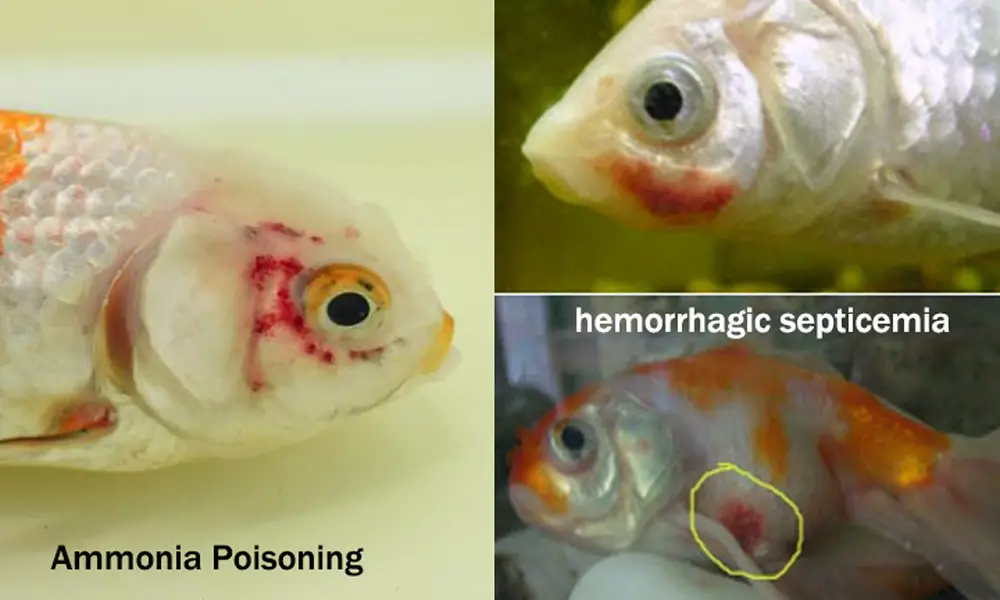
The last common reason your goldfish have red spots might be ammonia poisoning, one of the biggest fish killers. Total ammonia in a fish tank is comprised of NH3 and NH4+. The former is extremely toxic to fish whereas the latter is not. However, as the water temperature or pH increases, the NH4+ shifts to NH3, toxic form.
Symptoms of Ammonia Poisoning in Goldfish
The high level of ammonia in the water makes it difficult for the fish to eliminate ammonia from their bodies [8], which will eventually cause stress, damage to the brain, gill, internal organs, and lead to death.
The signs of ammonia poisoning in goldfish include:
- Gasping at the surface of the water for breath
- Red or purple gills
- Lethargy
- Loss of appetite
- Bloody patches on the body
As to the red gills, people often confuse it with the clinical sign of hemorrhagic septicemia (red pest). In fact, it’s quite easy to distinguish between the two.
Red spots on goldfish gills caused by ammonia poisoning are internal, and they usually take on a deep red or purple color, not brownish red patches like those from hemorrhagic septicemia. Also, they don’t develop on the scales of the fish.
Treatment
If you read that the ammonia level in your fish tank is above 1 ppm, you need to take the following emergency measures to lower it.
- Do a 50% water change, and ensure the temperature of new and old water is the same.
- Use reverse osmosis (RO) water to lower the pH
- If the condition of your fish is still critical, you should use Amquel or Prime to remove ammonia.
- For fish exposed to high ammonia levels, you need to quarantine them in a hospital tank and treat them with antibiotics.
Final Thoughts
Well, now that you are up to date with all the information about red pest disease in goldfish, we can end our guide here.
Remember that the most common cause for this disease is unsanitary tank conditions. So, make it a point to purchase a water testing kit that will help you determine the water quality of your tank.
Furthermore, ensure that you keep the tank clean at all times and maintain a healthy diet for your goldfish to thrive. And that’s all we have for you today; do take good care of your goldfish.
Article Sources:
- Transcription profiles of skin and head kidney from goldfish suffering hemorrhagic septicemia with an emphasis on the TLR signaling pathway [NCBI]
- Use of Antibiotics in Ornamental Fish Aquaculture [UF]
- What is Gram Staining? [SERC]
- Molecular mechanisms of membrane targeting antibiotics [Sciencedirect]
- Fast Facts about Viral Hemorrhagic Septicemia [CFSPH]
- Evaluation of nitrofurazone baths in the treatment of bacterial infections of Sparus aurata and Oreochromis mossambicus [Sciencedirect]
- Yersinia ruckeri, the causative agent of enteric redmouth disease in fish [VeterinaryResearch]
- Aquarium Water Quality: Nitrogen Cycle [fdacs.gov]
- How To Make Medicated Feed [Hikariusa]
- 10.3.6. Red Blotches [aquariumscience]
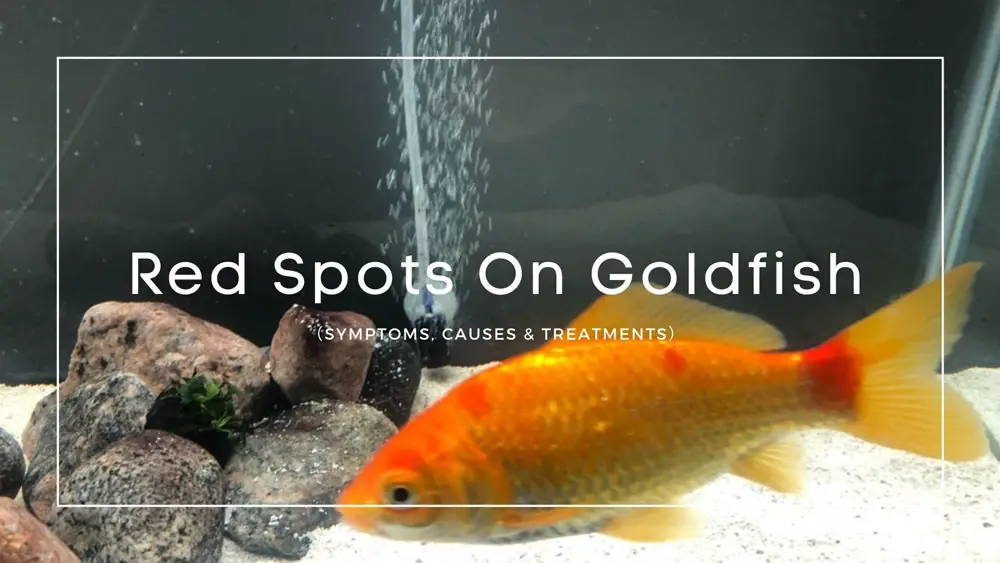





2 thoughts on “Red Spots On Goldfish: Symptoms, Causes & Treatments”
Hey Jeff . I have a couple of gold fish that have red spots .The fish are not really eating . I went to the store and they gave me a bacterial infection treatment solution. I don’t know if this is a high ammonia level issue or the fish have a bacterial infection . Please help with this cause I don’t want my fish to die . Thank you
Hello Stacy,
I am truly sorry to hear that your beloved goldfish are suffering.
The first step is to test the water for ammonia levels. The standard API liquid test kit is recommended and can be found at most pet stores. Any readings above 1 ppm of ammonia should be treated immediately. I suggest you perform a 50% water change to reduce the levels.
In most cases, it would be a bacterial infection; the treatment solution you were given should help.
I wish you luck with your goldfish and please keep me updated on their progress!
Kind Regards,
Jeff